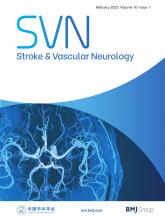We value the interest in our work (Schipani et al)1 expressed by Zhang et al2 in their recent letter to the editor. We welcome the opportunity to respond and offer the following clarifications.
Traditionally, spontaneous and traumatic cervical artery dissections (CeAD) have been classified separately. However, despite conflicting results from observational cohorts,3 there is currently no convincing evidence supporting significant differences in the underlying pathophysiology between the two types. Therefore, we believe this distinction to be arbitrary.
Regarding the recommendation from Zhang et al to stratify the analysis based on risk factors, we note that doing so would significantly reduce the sample size in each subgroup, which would, in turn, diminish the power of the analysis and the ability to detect meaningful differences. Moreover, such an approach falls outside the primary scope of our investigation, which focused on an exploration of sex differences in CeAD. Lastly, we acknowledge that the relatively small sample size in our study is a limitation, and we agree that our findings require validation with larger cohorts. We hope our work catalyses future studies that can build on these preliminary insights and provide more robust evidence.
We appreciate the thoughtful engagement of Zhang et al and look forward to ongoing discussions in this area of research.
Ethics statements
Patient consent for publication
Ethics approval
The referenced study was deemed exempt by the Mayo Clinic Institutional Review Board due to the retrospective cohort study nature of the study.
Footnotes
X @ElkeSchipani, @zaferkeserMD
Contributors All authors contributed equally to the work.
Funding The authors have not declared a specific grant for this research from any funding agency in the public, commercial or not-for-profit sectors.
Competing interests None declared.
Provenance and peer review Not commissioned; internally peer reviewed.
This is an open access article distributed in accordance with the Creative Commons Attribution Non Commercial (CC BY-NC 4.0) license, which permits others to distribute, remix, adapt, build upon this work non-commercially, and license their derivative works on different terms, provided the original work is properly cited, appropriate credit is given, any changes made indicated, and the use is non-commercial. See: http://creativecommons.org/licenses/by-nc/4.0/.






